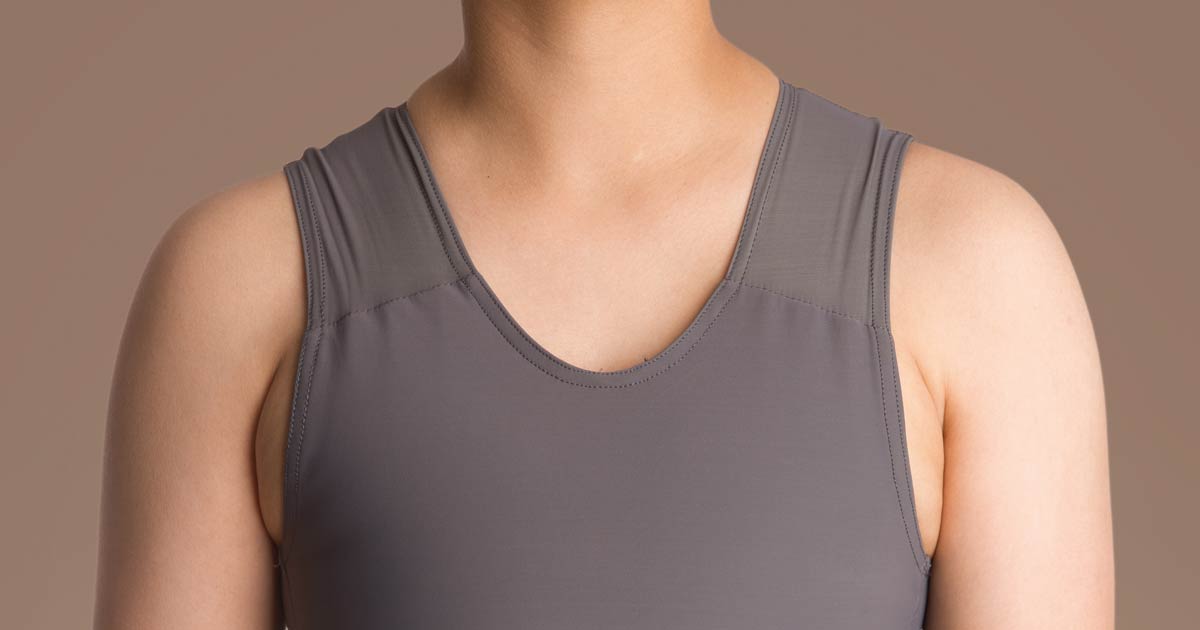A parent's guide to buying a chest binder for your child

Maybe your child has come out to you as trans or non-binary, or maybe they've simply shared that they wish to wear a chest binder. If you're a parent or guardian who is unfamiliar with what a chest binder is or what to do next, you're in the right place.
What is a chest binder?
A chest binder is a specially-designed compression garment designed to flatten the chest/breast tissue to create a more masculine or gender neutral appearance. Commercial chest binders are designed for compression and safety, and are the safest method as compared to wearing multiple sports bras, using tape or bandages, etc.
While anyone of any gender may choose to bind their chest, for many trans and non-binary individuals, it is a vital tool in alleviating gender dysphoria: the feeling of distress that may occur for people whose internal sense of gender is different from the sex they were assigned at birth. In short, wearing one helps many trans youth and adults feel more at ease, confident, and safer when in public.
And for young people who might be questioning their gender identity or presentation, even if they don't ultimately identify as transgender, wearing a chest binder is also a way for them to explore and learn more about themselves.
The benefits
A 2017 survey found striking mental health benefits as a result of binding: roughly 70% of individuals reported a positive mood after starting to bind, compared to only about 7% beforehand. This pairs with another finding of the same study in that 87% of individuals reported using binding as a method for achieving congruence between their gender identity and physical appearance.
At Point of Pride, we regularly hear from youth and adults about how wearing a chest binder is transformative for their mental health and their overall ability to show up more authentically and confidently, whether that's in the classroom, the workplace, or everyday life.
"My binder has helped me so much in reducing social anxiety when in public. I'm misgendered a lot less."
"With a binder, I'm not as concerned about my physical appearance or dysphoria. I can focus on living my life and being comfortable. It means the world to me."
"Wearing a binder boosts my confidence and helps me feel at home in my body. I feel so content and free around my friends and family now."
Health considerations: putting safety first
Wearing a binder is not without some risk, and binding improperly or for too long can lead to chest and back pain, rib bruising, shortness of breath, overheating, and skin irritation.
In order to ensure your child's safety, we always recommend paying close attention to:
- binder size. It's not uncommon for some people to try to wear a binder that is a size smaller than what their measurements indicate in the hopes it produces a flatter result. Not only is this ineffective, but wearing a binder that is too small can be dangerous. It's important to measure following your retailer/manufacturer's instructions on how to measure properly.
- the amount of time your child binds. More frequent and longer durations of binding are associated with an increased risk for health issues. So, healthcare providers and community members use the rule of thumb that people should not bind for longer than eight hours a day. The more breaks, the better. You may choose to talk with your child about days where binding is less important and times they can go without wearing it (i.e. on the weekend, when around the house) as well as discuss strategies for finding breaks during a longer or busier day (i.e. when at school or work for extended periods of time.)
- activity. Because there is little data and conflicting information on health risks of binding while exercising or swimming, many providers and manufacturers recommend you do not bind while doing any high-intensity activities. Wearing a binder while working out can make movement and breathing more difficult. Additionally, we always recommend taking a binder off before going to sleep as a way to give your body an extended rest period.
If binding is ever painful or uncomfortable, or if there's difficulty breathing, stop right away. Always talk to your child's healthcare providers if you have questions regarding binding.
Choosing the right chest binder
Finding the right chest binder is essential for comfort and effectiveness.
- Follow sizing charts: Different binder brands may have their own sizing charts, so be sure to check the specific measurements they provide for each size. Compare your child's measurements to the brand's sizing recommendations to determine the right size.
- Consider material and style: Binders come in various materials (e.g., spandex, nylon, cotton) and styles (e.g., full tank, half tank, pullover). Consider what material and style will work best in terms of comfort and daily activities.
- Compression level: Different binders offer varying levels of compression. Some provide stronger compression for a flatter chest, while others offer a more relaxed fit.
- Breathability: Pay attention to the breathability of the fabric and try to select one that allows for proper ventilation to prevent overheating and discomfort.
- Ease of putting it on and taking it off: Some binders have front zippers, hooks, or velcro closures, while others are pullover style. Consider how easy it is for your child to put on and take off the binder, especially if they have mobility or dexterity concerns.
- Brand reputation and reviews: Well-established brands that specialize in gender-affirming clothing may offer more reliable and comfortable binders. Look for reviews and recommendations from other folks in the community before you purchase.
- Speak with an affirming healthcare professional: If you have specific medical or physical concerns related to binding, consult with a knowledgeable healthcare professional or gender-affirming specialist. They can offer guidance on safe binding practices and recommend appropriate products.
Shopping tips
Some brands to consider as you research:
There may be local retailers or boutique shops that carry chest binders from these manufacturers and more. Deciding where to purchase a chest binder depends on your child's preferences, your level of access, and your level of comfort.
Online
Pros: If your child is not comfortable trying on binders in a public setting, online may be the way to go. Additionally, online retailers often have a broader range of options in terms of sizes, styles, and colors, allowing your child to find a binder that suits their preferences more easily. You can also easily read reviews and comparison shop across different retailers to find the best deal.
Cons: When shopping online, you can't try on or feel the materials of a binder before your purchase, which can lead to issues with comfort or effectiveness. Depending on your location and the retailer, shipping times may be significant, and returns or exchanges may also take some time.
In-store
Pros: In-store staff can provide assistance with sizing, fitting, and guidance based on your child's preferences. You'll have confidence that the binder fits properly before making a purchase, often in a supportive and affirming environment.
Cons: In-store options are often limited in terms of sizes, styles, and colors. Most importantly, your ability to access a brick-and-mortar store that sells binders may be limited, depending on where you live.
Binder donation programs
Not everyone is able to afford or easily obtain a chest binder. Point of Pride operates one of the largest free chest binder donation programs of its kind, serving thousands of people in all 50+ states and around the world. The chest binder and all shipping expenses are 100% free for recipients, and we operate on a first-come, first-served basis. Our only requirements would be that your child identify as trans and they/your family have financial need or other barriers that make it difficult to obtain a binder.
Some other donation programs include:
- Binder Drive (U.S.)
- Genderbands (U.S.)
- American Trans Resource Hub (U.S.)
- Qmunity's Bra, Binder, and Breast Forms Exchange Program (Canada)
- GenderGear (Canada)
In addition, many GSAs, community organizations, and trans support groups have their own smaller, localized binder donation programs. We recommend reaching out to LGBTQ+ organizations in your area to see if one such program might be available near your family. If you live in the U.S., CenterLink's Community Center Directory is a great tool to start your search.
Closing thoughts
Trans and gender-diverse young people who are supported by their parents and guardians are 2x more likely to report life satisfaction, 5x more likely to report high self-esteem, and 4.5x more likely to describe their mental health as “Very Good” or “Excellent.”
Allowing your child to have a chest binder—and having open conversations about safer binding techniques, as well as other areas of their journey—is just one way you can approach them with love, compassion, and a willingness to learn. Thank you for being here!
Related reading & resources

Written by Point of Pride
Point of Pride provides financial aid and direct support to trans folks in need of health and wellness care.


